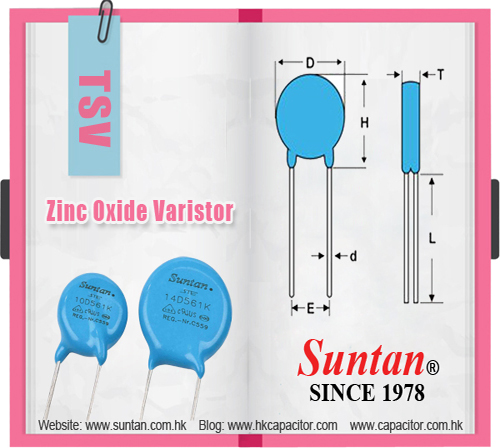Suntan Metal Oxide Varistor Introduction---( MOVs or VDRs )
Suntan Technology Company Limited
----All Kinds of Capacitors
Metal Oxide Varistor (MOV) is also known as Varistors that stands for variable resistors. It is a voltage-dependent resistor (also known as VDR) with bidirectional and symmetrical V/I characteristics.

Metal Oxide Varistor Application :
1. Equipment Protection against Line Transient Damage
2. Protection of Components Switching Inductive Load
3. Transient Protection of Solid State Circuit
4. Extend the Life of Relay Contacts
5. LED Driver Surge Protection & LED ESD Protection
6. Thermally Protected Varistor Application Circuit
7. IC Protection against Electro-Static Discharge (SMD Varistor Application)
8. Noise Suppression (SMD Varistor Application)
9. USB Protection (SMD Varistor Application)
Varistors have been proven to be excellent protective devices due to their application flexibility and high reliability. The metal oxide varistor, with its extremely attractive price/performance ratio, is an ideal component for limiting surge voltage and current and for absorbing energy. Overvoltage protection devices like varistors are often referred to in international publications as a TVSS (transient voltage surge suppressors).
Metal oxide varistor is the most common type of varistor. We are one of the leading manufacturer of varistor. Our metal oxide varitor contains a ceramic mass of zinc oxide grains, in a matrix of other metal oxides (such as small amounts of bismuth, cobalt, manganese) sandwiched between two metal plates (the electrodes). Our products are with high quality which can guarantee your quality life.
Suntan MOV product portfolio offers 5, 7, 10, 14 and 20 mm radial leaded varistor devices which protect against overvoltage transients such as lightning, power contact and power induction. The metal oxide varistors offer a choice of varistor voltages from 18 V to 1800 V and Vrms voltages from 11 V to 1100 V. The devices have high current handling, high energy absorption capability and fast response times to protect against transient faults up to rated limits.